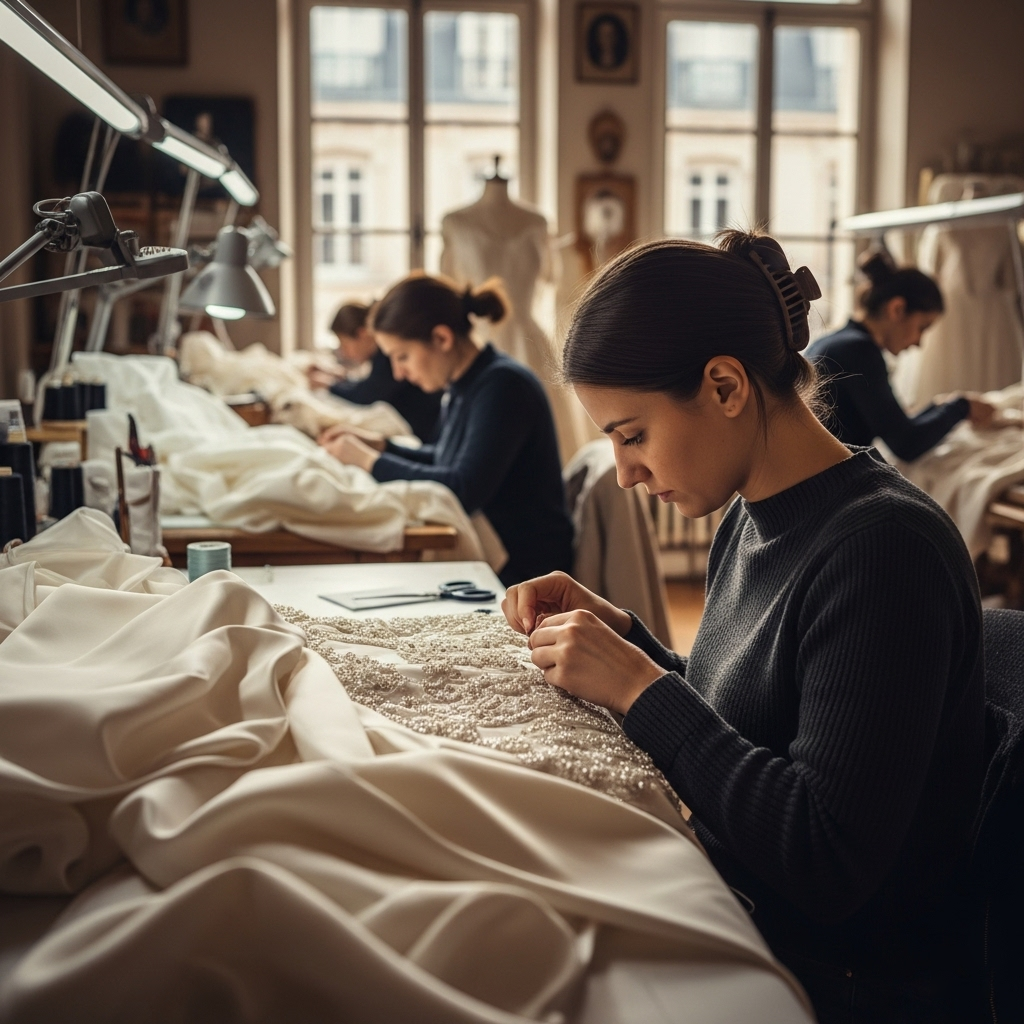Blog
The Craft of Couture: Inside the World of High Fashion and Artisanal Excellence

In the rarefied air of high fashion, where ephemeral trends often dominate, haute couture stands as an enduring testament to artistry, unparalleled craftsmanship, and a devotion to excellence that borders on the obsessive. This is not fashion for the masses; it is the pinnacle of sartorial creation, a world where garments are not merely sewn but sculpted, where creativity knows no bounds, and where the human hand reigns supreme. To step inside the world of couture is to witness the preservation of dying crafts and the relentless pursuit of perfection.
Defining haute couture isn’t just a matter of price or prestige; it’s governed by strict, legally binding regulations set by the Chambre Syndicale de la Haute Couture in Paris. To qualify as a haute couture house, a brand must:
- Design made-to-order clothing for private clients, with one or more fittings.
- Have an atelier (workshop) in Paris that employs at least 15 full-time technical staff.
- Present a collection of at least 50 original designs—both day and evening wear—to the public each season (January and July). These stringent criteria ensure that couture remains an exclusive domain of unparalleled skill and dedication, a far cry from even the most luxurious ready-to-wear.
At the very heart of haute couture lies the atelier and its extraordinary artisans, often referred to as the “petites mains” (little hands). These are master seamstresses, embroiderers, beaders, and tailors who possess decades of specialized training and inherited knowledge. Each atelier often has distinct sections: the flou (meaning “fluid” or “flowy”) for soft dresses, drapes, and delicate fabrics, and the tailleur (tailoring) for structured suits, coats, and more rigid silhouettes. The atmosphere is one of intense focus, quiet dedication, and meticulous precision. Every stitch, every bead, every feather is placed by hand, a process that can take hundreds, even thousands, of hours for a single garment. It’s a symphony of collaboration, with each artisan a virtuoso contributing to the final masterpiece.
The design process in couture is an elaborate journey. It begins with the designer’s vision – a mood board of inspirations, initial sketches, and fabric swatches. But unlike ready-to-wear, where designs are scaled for mass production, couture pieces are often draped directly onto a mannequin or a live model, allowing for organic evolution and immediate adjustments. Fabric selection is paramount, often involving rare silks, custom-made lace, unique weaves, and intricate embroideries that can be more expensive than precious jewels. The pattern cutting is exceptionally precise, ensuring that the garment drapes perfectly on the client’s unique physique. Then come the multiple fittings with the client, a truly bespoke experience where the garment is sculpted and refined directly on their body, ensuring an impeccable fit that is impossible to achieve with standard sizing.
The unparalleled craftsmanship is what truly distinguishes couture. Consider the techniques: hand embroidery that creates shimmering landscapes of thread and beads; intricate beading where sequins and crystals are painstakingly applied one by one; precise pattern cutting that ensures a garment flows effortlessly; custom fabric creation, where textiles are often hand-painted, pleated, or embellished uniquely for a single design. Each detail is a testament to the artisan’s skill and patience. Zippers are often hand-sewn, linings are hand-finished, and closures are meticulously concealed. The inside of a couture garment is often as beautiful as the outside, a mark of true luxury.
The bespoke experience is a cornerstone of couture’s appeal. For the discerning client, it’s a deeply personal journey. They become part of the creative process, attending multiple fittings, discussing details with the design team, and seeing a garment come to life specifically for them. This creates an emotional connection to the piece that transcends mere ownership; it becomes a collaboration, a wearable work of art that is uniquely theirs. It’s an investment not just in clothing, but in an experience of ultimate personalization and luxury.
While couture accounts for a tiny fraction of the fashion industry’s revenue, its role in fashion is immense. It serves as a laboratory for innovation, pushing the boundaries of textile technology, silhouette, and construction. Designers use couture collections to experiment with new ideas, materials, and techniques that might later filter down into ready-to-wear, or inspire broader fashion trends. It is a platform for artistic expression, where designers are free from commercial constraints to fully realize their creative visions, treating clothing as a form of sculpture or painting. Couture shows are grand spectacles, designed to generate prestige and media buzz, burnishing the brand’s image and attracting high-net-worth clients for their more commercially viable ready-to-wear and accessory lines.
One of the challenges facing couture today is preserving traditional skills. As fewer young people pursue these demanding and time-consuming crafts, there’s a risk that these invaluable techniques could be lost. Couture houses often invest in apprenticeships and training programs to ensure the continuity of their artisanal knowledge.
In conclusion, haute couture is more than just expensive clothes; it is a living art form, a meticulous dance between creative vision and exceptional skill. It embodies the enduring value of human craftsmanship in an increasingly automated world. It is a world where time is measured not in minutes, but in stitches, and where every garment is a testament to the relentless pursuit of beauty and perfection. Haute couture stands as a beacon of artisanal excellence, reminding us that true luxury lies in the extraordinary human touch.
